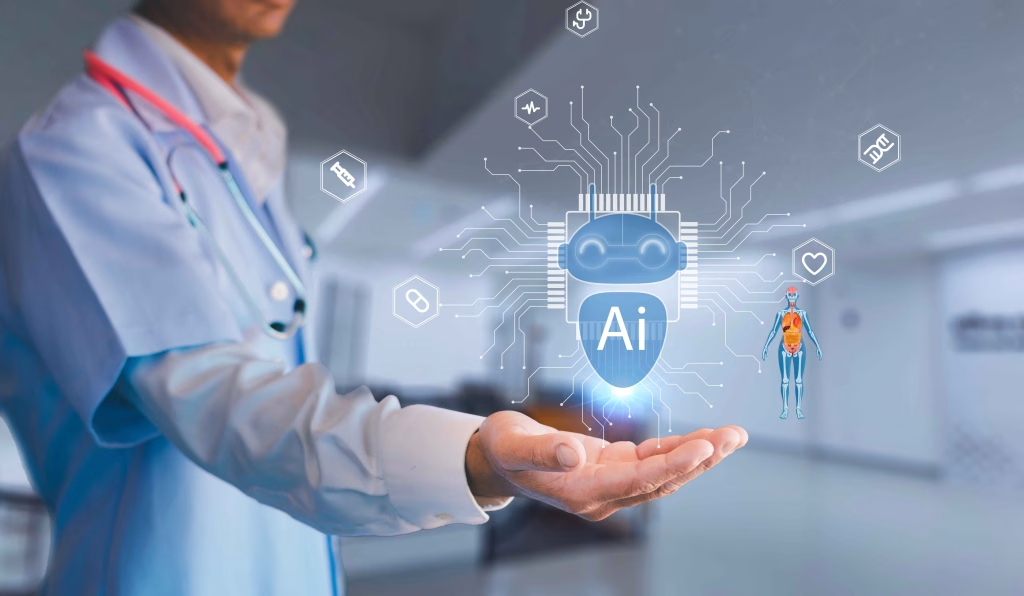
Artificial Intelligence now drives changes in almost every part of healthcare, from X-rays and MRIs to doctor visits and wearables Long waits, missed symptoms, and assumptions are becoming fewer in number. In this blog, we’ll talk about the AI revolution that’s changing healthcare today, the challenges and the path ahead.
Smarter Diagnostics & Medical Imaging
Deep learning is changing the way AI systems read medical images. AI tools are getting better at finding problems like tumours, skin lesions or micro fractures by training on huge datasets of X-rays, CT scans, MRIs, PET scans, and more. They can often do this much faster than humans. They help radiologists by pointing out cases that are suspicious or important and speeding up the process.
AI is also helping with imaging in fields like ophthalmology, pathology and dermatology. These advances are making it easier to find disease earlier, which results in better treatment.
Predictive & Preventive Medicine
Prediction is one of AI’s strongest features. AI models can estimate risk for diseases like diabetes, cardiovascular disease, or cancer by combining patient history, genetics, lifestyle, imaging, lab results, and by continuous monitoring.
These enable preventive measures like lifestyle changes, early screening tests, rather than reacting after the disease has progressed.
Predictive AI also helps with disease progression models, forecasting how a disease may evolve which supports personalized treatment planning.
Clinical Workflow & Decision Support
Diagnosis is only one aspect of healthcare delivery; other tasks include assessing, scheduling, monitoring, follow-ups, administrative burden, and more. AI is streamlining many of these operations. For example:
- Triage systems: AI algorithms can help prioritize patients in emergency rooms or telemedicine settings.
- Electronic Health Records (EHRs): AI reduces the amount of time clinicians spend documenting by extracting insights from unstructured clinical notes.
- Real time alerts: Monitoring vital signs, lab results, or imaging can generate alerts for important changes and assist in a quicker action.
Remote Monitoring & Telehealth
With the rise in wearables, home sensors, and telemedicine, there is more health data being generated than ever before. Real-time interpretation of this data is enabled by AI. Applications include:
- Monitoring long-term illnesses like diabetes or heart disease.
- Notifying medical professionals when the metrics of a remote patient deviate from acceptable limits.
- Using AI-assisted imaging or diagnostics in remote areas via smartphone or portable devices.
These are particularly relevant in areas with limited access to specialised care.
Ethical & Regulatory Consideration
It’s not enough to build powerful AI tools; they must be safe, fair, and trustworthy. Key issues of deploying AI in medical settings are:
- Bias & fairness: We must use datasets that accurately represent diverse populations to eliminate bias and promote fairness. If not, models underperforming on unrepresented groups.
- Data security and privacy: Because medical data is so sensitive, it is crucial to comply with regional privacy laws such as GDPR and HIPAA.
- Regulatory oversight: Approving AI tools for clinical use requires thorough validation, trials, and often the participation of regulatory agencies (such as the FDA and CDSCO in India).
Challenges Ahead
Despite tremendous progress, there are challenges also:
- Annotation and data quality: AI is only as good as the data it is trained on. Accurate, well-labeled, high-quality data is costly and time-consuming to obtain.
- Generalization: Models that work well in one hospital or region may fail in another because of differences in equipment, patient demographics, or disease prevalence.
- Cost & access: Developing, validating, and deploying AI tools requires investment.
Key Insights
AI changes modern healthcare by transforming how we detect, treat, and prevent illness. AI promises to improve results, make systems more efficient, and increase access to high-quality care through improved imaging diagnostics, predictive models, streamlined workflows, and remote patient monitoring. However, its success depends on reliable data, ethical practices, effective regulation, and inclusive implementation.
Medrays plays a crucial behind-the-scenes role in this ecosystem by producing high-quality labeled datasets across many medical fields. Its work ensures that AI models are trained on accurate, well-verified data, which is essential for achieving much of the potential of AI in healthcare.
